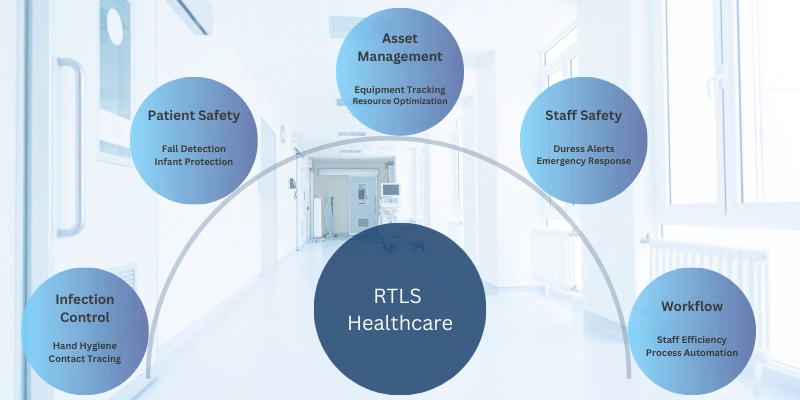Real-Time Location Systems (RTLS) are revolutionizing healthcare efficiency by providing hospitals with real-time tracking of patients, staff, and medical equipment. As healthcare facilities face increasing pressure to improve patient outcomes while managing costs, RTLS healthcare solutions optimize workflows, improve resource allocation, and enhance patient safety. By integrating RTLS technology into their hospital infrastructure, healthcare providers can streamline operations, reduce costs, and improve overall care quality, representing a significant advancement in healthcare operations management.
RTLS is a location-based technology that enables real-time tracking and monitoring within healthcare facilities. These systems utilize various advanced technologies to provide accurate location data and status updates for all tagged assets and individuals, forming the backbone of modern healthcare facility management.
RTLS (Real-Time Location System) healthcare solutions use a combination of advanced location technologies such as:
The strategic implementation of these technologies enables healthcare facilities to create a powerful infrastructure for real-time visibility and control.
Modern RTLS solutions seamlessly integrate with various healthcare management platforms, creating a unified ecosystem for healthcare delivery:
This integration capability represents a significant advancement in healthcare technology, enabling comprehensive data sharing and improved decision-making across departments.
RTLS significantly improves patient safety through:
These capabilities demonstrate how RTLS technology directly contributes to improved patient outcomes and safety protocols
Healthcare facilities can optimize their resources through:
This comprehensive asset management approach helps healthcare facilities maximize their investment in medical equipment while reducing operational costs.
RTLS improves operational efficiency by:
These improvements in workflow efficiency allow healthcare providers to focus more time on patient care and less on administrative tasks.
The system supports infection prevention through:

RTLS provides real-time tracking of mobile medical equipment (MME) such as ventilators, IV pumps, and wheelchairs. This capability:
The system delivers comprehensive patient safety features:
RTLS enhances workplace safety through:

When selecting an RTLS system, healthcare facilities should consider:
Healthcare facilities implementing RTLS in their emergency departments have reported significant improvements:
Hospitals utilizing RTLS for equipment tracking have experienced notable benefits:
A behavioural health facility utilized RTLS for staff safety:
The healthcare RTLS landscape is experiencing rapid transformation, driven by technological advancements and evolving healthcare needs. These emerging trends are reshaping how healthcare facilities approach patient care, resource management, and operational efficiency.
AI and Machine Learning are transforming RTLS in healthcare by analyzing historical data to improve accuracy and predict bottlenecks. AI-powered systems can anticipate equipment demands and trigger maintenance before failures occur.
The expansion of IoT has created a more connected healthcare environment, where RTLS integrates with medical devices to track location, status, and usage. This enhanced visibility improves operations, from monitoring medication storage to tracking sterilization of surgical tools.
Hybrid systems further enhance RTLS by combining technologies like BLE for general tracking and UWB for precise location data in critical areas, optimizing both cost and performance.
Predictive modeling in RTLS has revolutionized resource management by forecasting patient volumes, optimizing staff schedules, and predicting equipment needs. Emergency departments can anticipate surges, while operating rooms adjust schedules based on past procedure durations.
Real-time decision support systems now offer dynamic recommendations, reallocating resources as needed—such as directing cleaning staff to high-demand areas or redistributing equipment during peak times. This data-driven approach enhances efficiency and resource utilization.
While RTLS offers significant benefits, healthcare facilities face several hurdles in deployment and maintenance.
Full RTLS coverage requires careful sensor placement, reliable network connectivity, and power management, especially in facilities with thick walls and complex equipment. Accuracy can vary due to signal interference, requiring continuous calibration. Battery life management is also critical, balancing frequent updates with long-term usability.
Beyond initial costs, RTLS requires ongoing investments in maintenance, software updates, and tag replacements. Staff adoption is another challenge, necessitating thorough training and clear communication of benefits to ensure smooth integration into workflows.
RTLS must comply with HIPAA regulations, implementing strong security measures to protect patient data. Seamless integration with existing hospital systems, such as EHRs and asset management platforms, requires meticulous planning and ongoing system maintenance.
RTLS in healthcare is evolving with enhancements like better mobile integration, extended battery life, and more intuitive interfaces to improve usability and address current challenges.
In the long term, AI-driven automation, seamless system interoperability, and advanced predictive capabilities will further optimize hospital operations. As technology advances and costs decline, RTLS will become more accessible across healthcare facilities.
While implementation requires careful planning, the benefits—improved patient outcomes, efficiency, and cost savings—make RTLS a vital investment for the future of healthcare.
📍 We’re expanding our horizons! Stay tuned for upcoming product and service launches.📍
©2024 anyRTLS, All rights reserved.